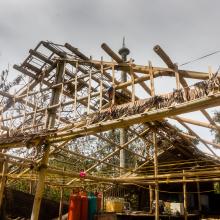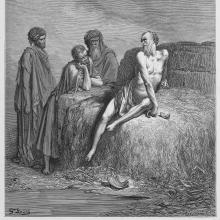Haiyan
IN THE EARLY evening of Nov. 8, 2013, Arnel Montero convinced his mother, wife, and three children to evacuate to a two-story concrete house above the coastal area of Barangay 70, a fishing village in Tacloban City, on the island of Leyte in Central Philippines. He expected the worst, with the news reporting the arrival of super-typhoon Haiyan the following morning, and thought the house would be a safe place where his family could take shelter while he remained in their shanty by the coast.
Even though Haiyan’s fury hit the islands at speeds surpassing 200 miles per hour, the strong winds alone would not have created such a major tragedy. But Haiyan precipitated a storm surge that led to grave loss of life and massive devastation. Barangay 70 is located near the city’s main pier, and the tidal waters pushed cargo boats toward the coast, smashing shanties and buildings, including the concrete house where Arnel’s family sought shelter. Arnel managed to save himself, but the rest of his family perished.
The National Disaster Risk Reduction and Management Council, as of mid-March 2014, reported 6,268 deaths, although the actual number could be double that. In Barangay 70 alone, there were close to 300 people who died. An estimated 12.2 million Filipinos were affected by the disaster that hit eight provinces in the Visayas islands region; close to 2 million houses were either washed out or partially destroyed.
The national and local government’s response to the massive need for relief operations was slow. Political bickering, incompetent local governments, and the sheer inefficiency of the administration of President Benigno Aquino all contributed to major delays in bringing food, potable water, clothing, medicine, and temporary shelter to the survivors. Weeks after Haiyan struck, interior villages still had not received aid. It was not until early January 2014 that government relief agencies managed to set up the systematic distribution of relief goods.
The world of Christian theology has seen its fair share of writings that address horrible suffering and the confusion about God’s character that it causes. The question has been on my mind in light of the Philippines’ calamity. Although satisfying answers are difficult to come by with a topic like this, I offer a few insights that have helped me to continue to trust God’s love. The biblical character of Job shows us how, as believers in a loving God, we should regard and respond to suffering around us.
It no longer surprises me when I hear people express cynicism and doubt about a caring God — I sometimes wonder why more Christians have not done so. Whose faith can remain undisturbed when Typhoon Haiyan kills 5,000 Filipinos and inflicts misery on thousands more? I recall a photo of a woman weeping by her child’s body inside a damaged church. Who can imagine her despair? Can we conceive of the hell endured in the same region by enslaved women and girls who are raped and degraded every day, every hour?

